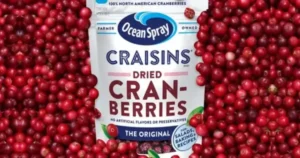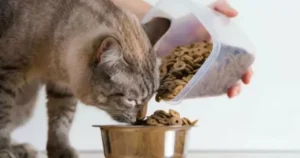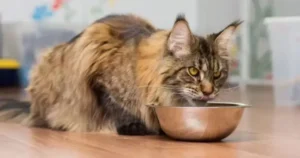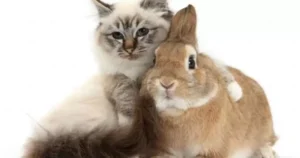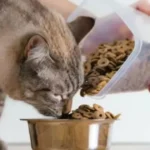Temptation is a popular brand of cat treats made by The J.M. Smucker Company. The treats contain real chicken or salmon as the first ingredient and are marketed as being irresistible to cats. The Temptations lineup includes treats like Catnip Flavors, Dental Treats, Mix-Ups, and Purely Natural.
Is Temptations Cat Food Good For Cats? This is a common question cat owners have regarding these enticing feline treats. With flavor varieties like tuna and cheese, it’s no wonder cats go crazy over Temptations. But are these snack-like treats healthy, or are they more like kitty junk food?
While cats love Temptations, pet experts are divided on their nutritional value. Some argue they are too high in carbohydrates and calories to be daily treats. Others say they are fine in moderation. More research may be needed to determine if Temptations supports good cat health or simply feeds feline cravings.
Key Takeaways
- Temptations are snack/treat foods, not meant to be a complete dietary meal. They are very high in fat, calories, and carbohydrates compared to regular cat food.
- In moderation, Temptations can be an okay snack or supplement. But feeding too many can lead to obesity, diabetes, and other health issues if that’s the bulk of the cat’s diet.
- Temptations often contain corn, wheat, soy, and artificial flavors – inexpensive fillers, but not very nutritious. They may also contain preservatives like BHA, BHT, and ethoxyquin.
- Many cats find Temptations very palatable due to the high fat and additive content. This makes it easy to overfeed them as treats. Cats should only have treats like Temptations in moderation.
- Some better quality cat treats have more meat content and fewer cheap fillers and additives. Looking for options without preservatives, grains, or artificial ingredients is best.
An Irresistible Feline Treat – But Is It Truly Good for Cats?
With irresistible taste and tantalizing textures, Temptations cat treats live up to their name for most felines. These snack-like tidbits come in flavors like tuna, salmon, chicken, and catnip, often sending cats into tail-spinning delight at just the rustle of a treat bag. But are these ultra-palatable nibbles healthy for cats? Or are Temptations more like the kitty equivalent of potato chips – tasty yet nutrition-poor junk food?
Nutritional Pros and Cons of Temptations Cat Treats
Protein Content
The primary ingredient in most Temptations recipes is real chicken, tuna, salmon, or shrimp. This contributes essential protein for strong muscles, organ health, and a healthy coat and skin. The treats also supply other key nutrients like vitamin E, niacin, vitamin B12, and zinc. So in these ways, Temptations offer valuable nutrition for cats.
Carb and Calorie Content
Temptations also contain significant amounts of starch, carbohydrates, and calories relative to their small size. Some veterinarians argue this makes them more like feline junk food than a nutritious snack. The calorie density combined with irresistible flavors means it’s easy for cats to overindulge, potentially leading to obesity and related health issues over time.
Are “Healthier” Alternatives Like Temptations Mix-Ups and Dental Treats Better Choices?
Temptations offers some “healthier” alternatives like Mix-Ups with veggies and Dental Treats for tartar control. But these still contain significant carbs and calories. Some experts argue ingredients like pea fiber and corn gluten meal serve more as cheap fillers than beneficial nutrition.
Moderation Remains Key With Temptations Cat Treats
| Nutrition Facts for 1 Ounce of Temptations Tuna Flavor Treats | |
| Calories | 138 |
| Protein | 7 g |
| Carbohydrates | 14 g |
| Fat | 5 g |
So are Temptations Cat Treats healthy overall? The answer likely comes down to moderation. Used occasionally as a special snack, Temptations can add excitement and enjoyment to a cat’s diet. relying on them for too large a portion of a cat’s daily calories can lead to unhealthy weight gain over time.
Try limiting treats to 10-15% of a cat’s total daily caloric intake at most. And focus their main nutrition on high-quality cat food appropriate for their age and activity level. Within this balanced approach, an occasional temptation tidbit remains an innocent – and much appreciated – kitty pleasure.
Ingredient Profile: How Wholesome Are Temptations Cat Treats?
To better understand Temptations nutrition and whether they support good feline health, let’s delve deeper into some common ingredients across recipes.
Chicken and Fish Content
Most Temptations feature real chicken, tuna, salmon, or shrimp as the predominant ingredient. This supplies high-quality animal protein for muscular health and converts it to key nutrients once digested. However, the amounts still prove relatively small compared to cats‘ complete daily nutrition requirements. While Weruva A Good Cat Food may contain more meat protein overall, many owners still like to use Temptations as supplemental treats in moderation. Ultimately it comes down to understanding the difference between main nutrition and snacks.
Plant-Based Carbohydrates and Fillers
Many Temptations also contain significant amounts of rice flour, oat fiber, pea fiber, or corn gluten meal. These serve as binders and shelf-life preservers, but their nutritional value for cats remains questionable. Some experts consider them non-essential fillers or empty carbs.
Artificial Flavors and Colors
While Temptations emphasize “natural flavors” on labels, a peek at ingredients shows most recipes also contain Red 40 Lake coloring along with other synthetic agents. These offer no nutritional value.
Fat Content and Quality
Some Temptations list generic “animal fat” on labels rather than specifically identifying the fat source. Treats like the Seafood Medley have higher overall fat content to carry the flavor. But whether this comes from healthy animal or plant oils remains unclear.
FAQ’s
What are Temptations cat treats made of?
Temptations consist mainly of rice flour, corn meal, chicken fat, and sugar with some dried meat pieces mixed in.
Do cats like the taste of Temptations treats?
Yes, cats love Temptations due to the palatability enhancers and flavor extracts used in their recipes.
Can I give Temptations to my cat every day?
No, Temptations should only be fed occasionally since they are high in carbohydrates and calories yet low in complete nutrition.
Are Temptations OK for diabetic cats?
No, the high sugar and starch content makes Temptations unsuitable for diabetic felines or cats prone to obesity.
What are some healthier cat treatment alternatives?
Some better options are freeze-dried meat treats, vegetable nibbles, or even tiny portions of canned cat food.
Conclusion:
Temptations cat treats certainly live up to their name in terms of irresistible taste and texture for felines. But Is Temptations Cat Food Good for Cats? when it comes to daily nutritional value? Therein lies the debate around these snack-like tidbits. While the first ingredient consists of real meat, providing decent protein, Temptations also derive significant calories from starchy fillers with limited nutrition. This suggests ideal enjoyment only as occasional treats, limiting to 10-15% of a cat’s diet.
The answer depends largely on portion control and balance with an overall high-quality diet. Within a moderate intake, the unique flavors and crunch Temptations offer enhance a cat’s experience. But as a steady diet replacement rather than supplement, their high carb and calorie load underdeliver essential nutrition vital to feline health. Moderation helps ensure they remain a fun surprise rather than a detrimental excess.


